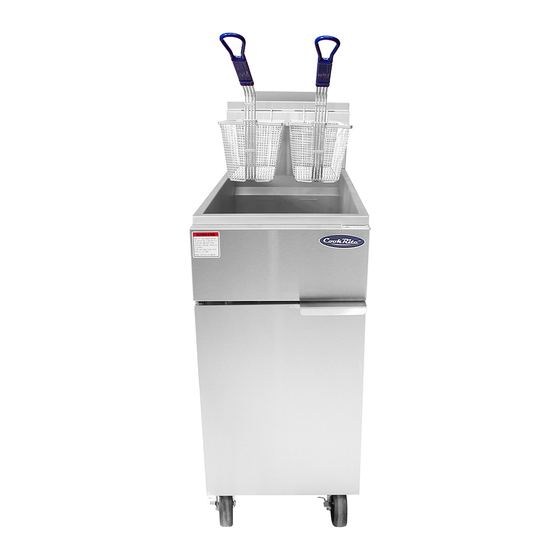
Advertisement
Table of Contents
- 1 Table of Contents
- 2 Safety Protection
- 3 Brief Introduction
- 4 Manufacturer's Authority and Responsibility
- 5 Parameter Specifications
- 6 Transport and Storage
- 7 Installation and Debugging
- 8 Safety Notices and Precautions
- 9 Operating Instructions
- 10 Cleaning and Maintenance
- 11 Service (Authorized Technicians Only)
- 12 Troubleshooting
- 13 Spare Parts
- 14 Accessories List
- Download this manual
Advertisement
Table of Contents

Summarization of Contents
Safety Information
Flammable Materials Proximity
Do not store or use flammable vapors or liquids near the appliance.
Installation and Maintenance Safety
Improper installation, adjustment, service, or maintenance can cause damage, injury, or death.
Safety Protection
Operator Qualifications and Responsibilities
Ensure operator is authorized and licensed technician for installation and operation.
Flammable Object Storage Warning
Do not store flammable or explosive objects around the product.
Gas Leak Response Protocol
If gas leak is smelled, turn off gas valves immediately and call the gas company.
Operator Age and Capability Requirements
Product should not be operated by those under 18 or with disabilities lacking knowledge.
Brief Product Introduction
Product Overview and Design
Describes the gas vertical type fryer as novel, structured, convenient, and durable.
Manufacturer's Authority and Responsibility
Unauthorized Product Modifications
Banning of partial or full transformation without manufacturer's explicit authorization.
Limitations of Manufacturer Responsibility
Manufacturer refuses responsibility for issues arising from improper use or unauthorized service.
Parameter Specifications
Outline Dimensions for ATFS-40/ATFS-50
Provides detailed outline dimensions for ATFS-40 and ATFS-50 models in inches.
Gas Supply and Burner Specifications
Outline Dimensions for ATFS-75
Provides detailed outline dimensions for the ATFS-75 model in inches.
Gas Supply and Burner Specifications
Details on minimum gas pressure regulator settings and intake-tube thread size.
Transport and Storage Guidelines
Handling and Warehouse Storage
Handle carefully, keep upright, store in ventilated, non-corrosive warehouse with rainproof measures.
Installation and Debugging Procedures
Installation Safety and Technician Requirements
Erroneous installation may cause damage or injury; work by authorized technicians.
Code Compliance for Installation
Install according to local codes, National Fuel Gas Code, or CSA codes.
Gas System Pressure Testing Protocol
Disconnect shutoff valve during pressure testing exceeding 1/2psi.
Unpacking and Initial Inspection
Dispose of packaging, check for damage, keep wrappers and receipts.
Leg Installation and Equipment Leveling
Install legs tightly, adjust to level equipment with other stoves.
Smokestack and Hanging Plate Assembly
Screw upper smokestack, attach hanging plate; refer to Figs 2, 3, 4 for methods.
Required Clearance and Airflow
Maintain 6 inches clearance on sides/back, 4 inches on bottom; avoid obstructing circulation.
Gas Leak Detection Procedure
Use soap water or tester to check for leaks; forbid open flame testing.
Equipment Debugging and System Testing
Comprehensive system test to ensure function and safety, identify potential problems before use.
Safety Notices and Precautions
Flammable Materials Proximity Warning
Do not place petrol or flammables nearby; keep surroundings clean.
Immediate Gas Leak Response
If gas is smelled, turn off main gas valve, extinguish flames, call 911.
General Operating Safety Rules
Do not touch hot parts, cover exhaust, turn off when not in use or for cleaning.
Service, Parts, and User Serviceability
Call for service for damage; no user-serviceable parts; do not operate with damaged parts.
Warning Against Unauthorized Part Changes
Never change parts without authorization to avoid hazards.
Operating Instructions
Pilot Light Ignition Sequence
Ensure thermostat is OFF, turn safety valve to PILOT, press and hold to light pilot.
Main Burner Ignition Procedure
After pilot light, turn temperature control knob clockwise to ignite main burner.
Oil Level and Ignition Safety
Ensure oil or shortening in cylinder before lighting main fire; do not over oil level line.
Procedure for Turning Off the Valve
Turn temperature control to OFF, then safety valve to PILOT for standby.
Cleaning and Maintenance Procedures
Cooking Process Guidance
Clean before first use, add oil/shortening, set temperature, use frying basket.
Oil Quality and Maintenance
Change or filter oil if peculiar smell due to high temperature or impurities.
Kitchen Ventilation Requirements
Install matched fume exhauster and ensure natural air circulation in kitchen.
Hydro-cylinder and Fryer Basket Cleaning
Clean inner part of hydro-cylinder, basket, grid, and drain pipe with detergent and water.
Equipment Exterior Surface Cleaning
Wipe equipment surface with clean clothing and mixed detergent, then dry.
Cleaning Agents and Safe Methods
Use mild detergent, avoid abrasives, vinegar, or corrosive liquids. Do not hose down.
Inner Smokestack Cleaning Schedule
Clean inner smokestack every 3-6 months or as needed by manufacturer or agent.
Pre-Cleaning Safety Checks
Turn off all control valves and ensure unit has cooled down before cleaning.
Annual Equipment Inspection
Comprehensively check equipment annually by authorized and licensed technicians.
Product Disposal Recommendations
Product is 90% metal, dispose according to local codes.
Service and Technical Adjustments
Main Burner Flame Adjustment
Check and adjust main burner for stable blue flame, proper thermocouple engagement.
Gas Pressure Regulator Calibration
Test gas supply pressure using a gauge and adjust regulating valve if needed.
Thermostat Calibration Procedure
Test and adjust thermostat by comparing set temperature with measured temperature.
Automatic Safety Controller Adjustment
Adjust controller to ensure appropriate flame surrounds thermoelectric couple for safety valve operation.
Troubleshooting Guide
Pilot and Main Burner Ignition Issues
Addresses issues like 'Not lighting' or 'Ignite pilot light but not main fire'.
Gas Flow and Flame Appearance Problems
Covers 'Close gas and heard a sound of fire' and 'Yellow flame and black smoke'.
General Fault Handling Advice
If fault occurs, stop using and contact technicians; turn off power and gas before maintenance.
Spare Parts Information
Procedure for Ordering Spare Parts
Order from authorized representatives; provide model, serial number, and description.
Warranty Policy for Replacement Parts
Company reserves right not to provide warranty for parts from other companies.
Accessories List
Included Accessories by Model
Lists accessories like adjustable steel leg, frying basket, flat screen, etc., per model.



Need help?
Do you have a question about the ATFS-75 and is the answer not in the manual?
Questions and answers